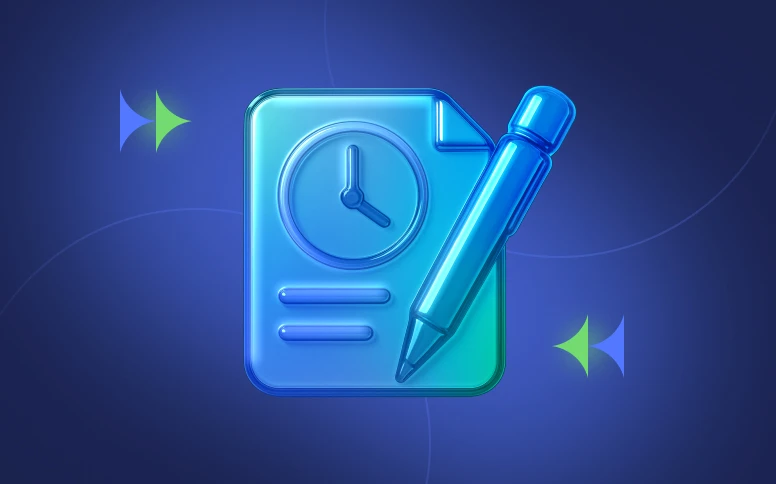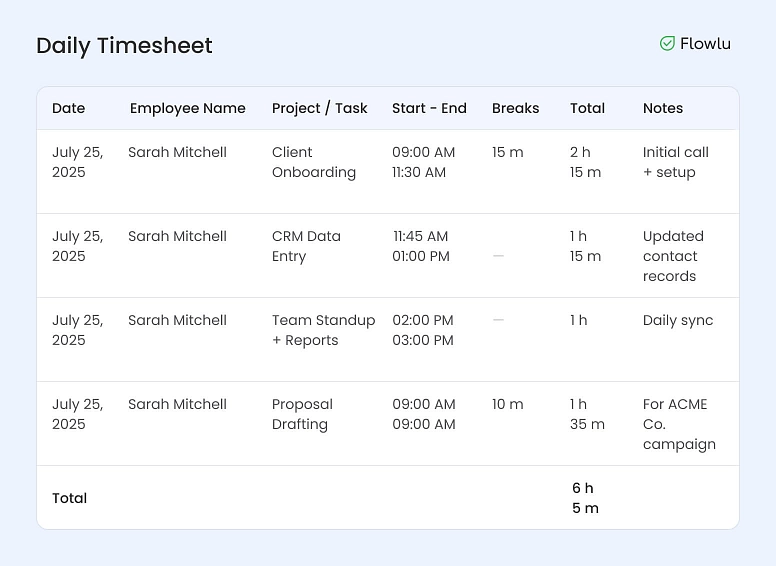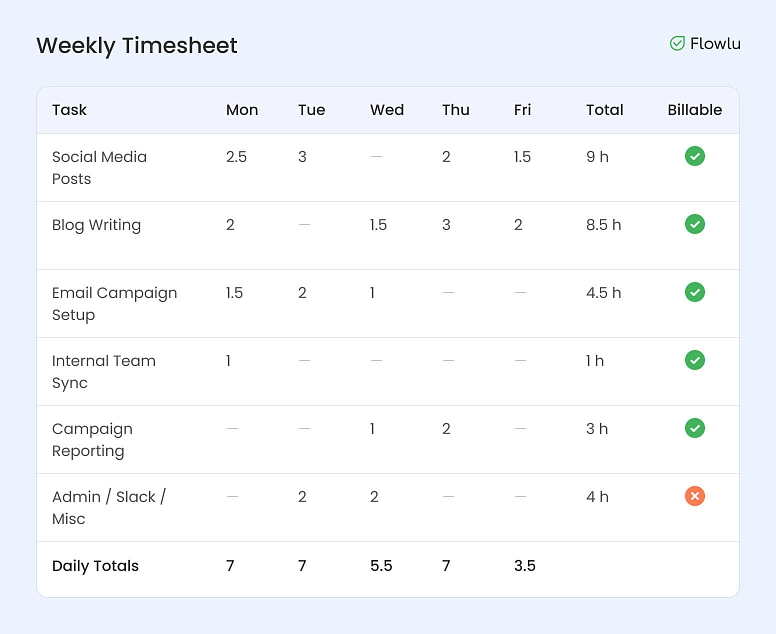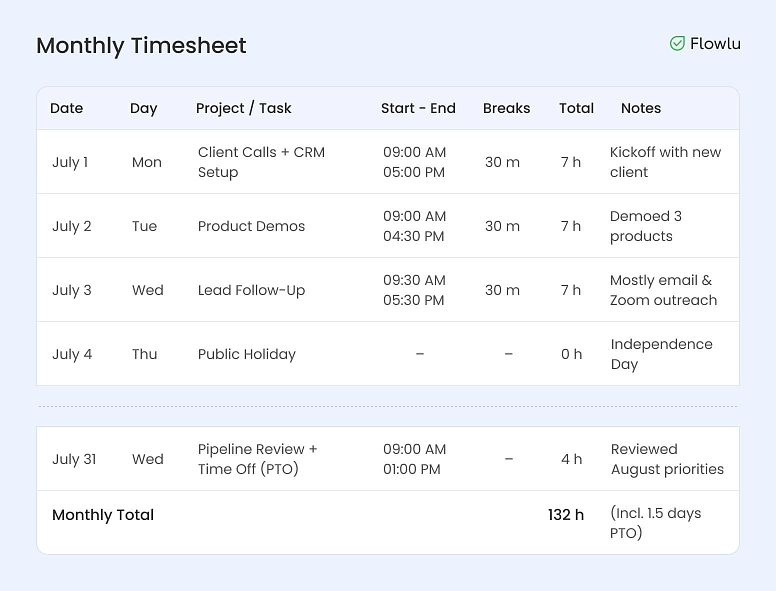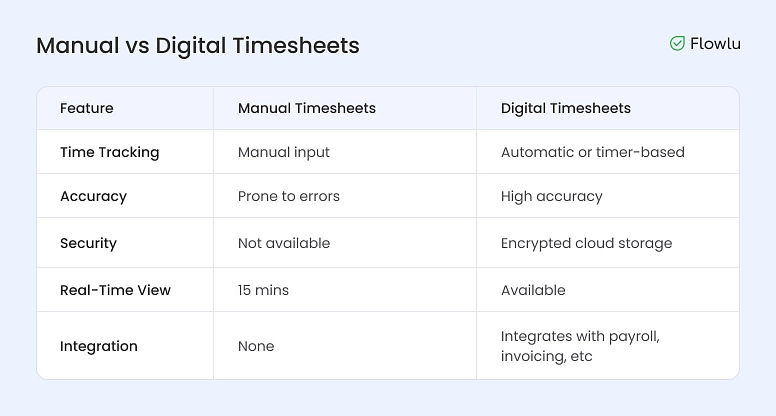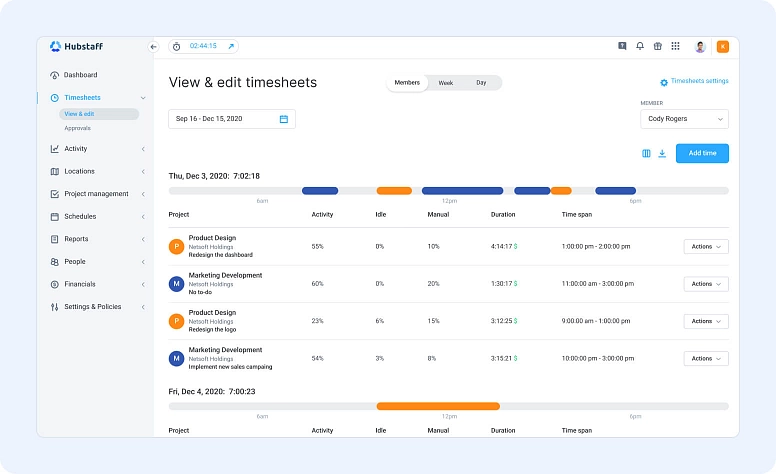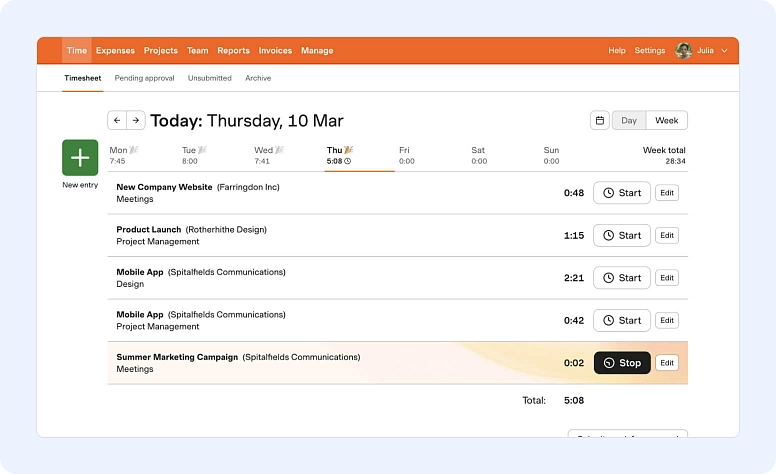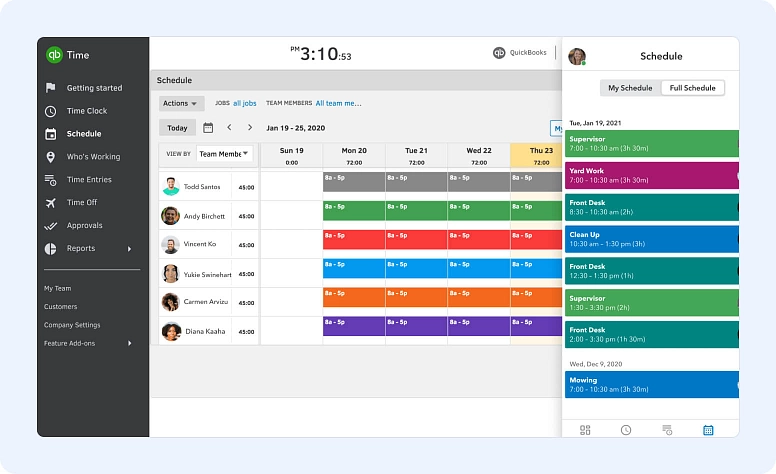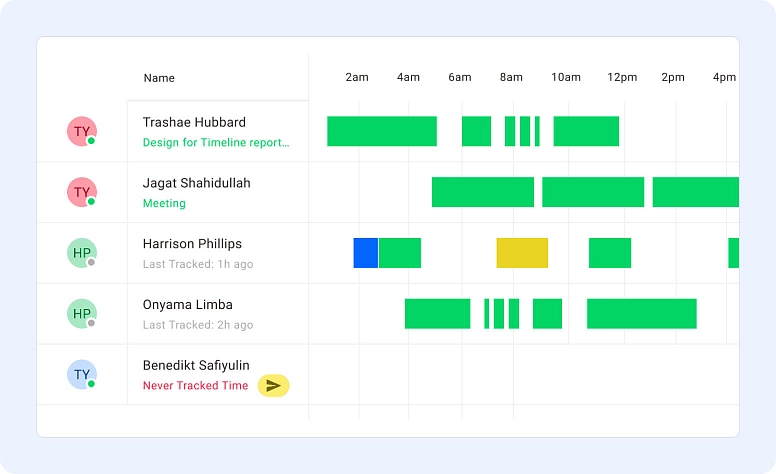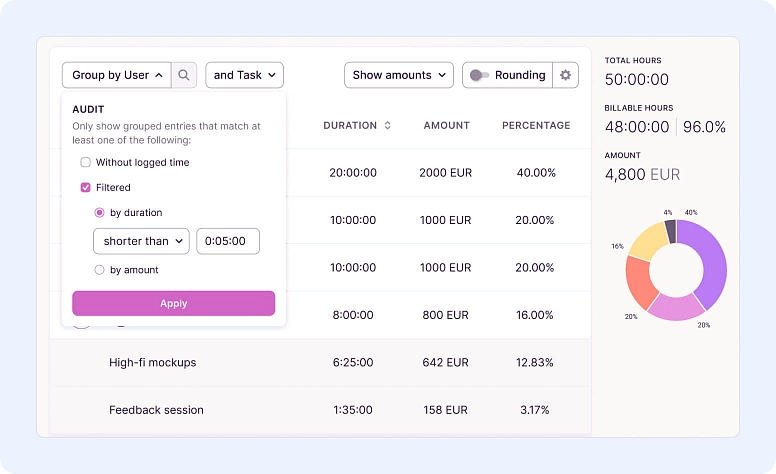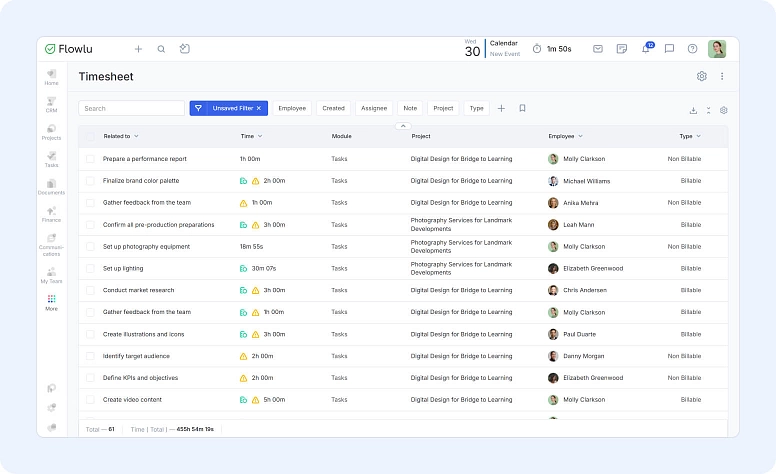What Is a Timesheet: Definition, Uses, and How It Works
When defining a timesheet, you can say that it’s a tool or resource that can help you with very important tasks, including tracking overtime hours, managing payroll, compliance with laws, and, above all, boost productivity.
But let’s start from the beginning and explain to you exactly what a timesheet is, what is the purpose of a timesheet, how a timesheet works, and the best way to use it. We will also show you some of the most popular timesheet software in 2025.
What Is a Timesheet?
Simply put, a simple timesheet definition is that it is a tool that may be digital or physical that allows you to record and keep track of time. Traditionally, timesheets were used to keep track of the working hours of each employee, and they were important to determine the employee’s wage.
While a timesheet continues to be used to keep track of time, it has evolved. Nowadays, timesheets can easily tell you how many hours an employee spent on projects, specific tasks, or other work tasks during a specific period that may be a day, week, or month, depending on your needs. But, a timesheet should also be seen as a tool that can help you improve the profitability and efficiency of your business or company.
The Purpose of a Timesheet
As we already mentioned above, the main purpose of a timesheet is to get an accurate record of the number of hours your employees worked. This is important for different reasons:
#1: Billing Clients:
A timesheet can be extremely helpful when it’s time to bill your clients. If you can accurately track the time spent on each task, you can charge your clients the right amount. This will increase trust with your clients.
#2: Project Management:
If you’re wondering what a timesheet management system is, we can say that it is a tool that will help project managers keep track of what each employee did, is doing, and what they will do next. By understanding this, they can allocate resources better and improve project planning at the same time.
When the project manager takes the time to check timesheets, they will be able to optimize workflows, identify bottlenecks, patterns, and trends, and make sure the project is delivered on time and on budget.
#3: Payroll Management:
Timesheets are always a help when it comes to payroll management. But their importance increases when businesses pay their employees for overtime or hourly.
#4: Employee Performance Evaluation:
As a business owner, you can compare two different timesheets of the same employee to determine if they need training or if they would be better doing other tasks, for example. You may also use this information to reward the best employees.
Types of Timesheets
If you’re looking to start using timesheets, it’s important to keep in mind that there are different types. The best one for you is the one that best fits your business needs.
Here are the main types of timesheets:
#1: Daily Timesheets:
As you can tell by its name, the employee needs to annotate the time at the beginning and end of the workday. These timesheets are the best ones for businesses that need to keep track of the working hours on a daily basis. Note: these timesheets may include overtime, breaks, and even projects worked on or specific tasks.
A simple example is when a company is delivering a fridge to your home.
#2: Weekly Timesheets:
The time track starts at the beginning of the week and ends at the end of the week. These timesheets should include overtime, regular hours, sick leave, and PTO.
A simple example is a common store where the owner needs to keep track of employee attendance to ensure they comply with workplace laws.
#3: Monthly Timesheets:
As you can easily understand, with this type of timesheet, the employee will send you their timesheet on a specific day of the month. These can be especially helpful for employees who earn commissions or employees who work on long-term projects.
A common example is sales teams who need to keep track of the time each interaction with clients takes.
How Do Timesheets Work?
As we already mentioned above, timesheets are crucial for businesses to keep track of employees’ working hours. This is important for payroll management, project management, and billing clients with accurate billable hours.
Typically, employees usually fill out their timesheets every day, week, or month. They either write down their hours by hand or use a tool that tracks time for them. Then, a manager checks and approves the timesheet before it’s used for things like payroll, billing, or checking performance.
Timesheet Use Cases
The truth is that using timesheets can be very useful, no matter your business industry or business size. Here are some use cases of timesheets for specific industries:
#1: For Freelancers:
Most freelancers charge their clients by the hour. So, it’s incredibly important that they use timesheets to keep track of the time spent working for each client. This ensures they’re paid fairly for every hour worked.
#2: For Law Offices:
Just like freelancers, law firms tend to bill their clients by the hour. Timesheets make it easier to log time spent on consultations, case research, or court appearances. This ensures accurate and transparent billing.
#3: For Accountants:
Accounting businesses also have huge benefits from using timesheets. As it turns out, the more efficient they are, the more profits they will get. Tools like Flowlu can be especially valuable here. They offer built-in time tracking along with financial tools that help accountants manage client hours and invoicing from one place.
#4: For Construction:
Project managers are used to using timesheets in construction all the time. Not only can timesheets serve as work hours tracking, but they also allow for better resource allocation, shift planning, staying on budget.
5: For Agencies:
Marketing, design, and software agencies often handle multiple projects at once. Timesheets help track billable hours per client, analyze project profitability, and make sure nothing gets overlooked.
6: For Healthcare and Nonprofits:
In sectors like healthcare or nonprofits, staff hours often need to be reported for funding, audits, or compliance. Timesheets simplify the process of logging those hours, managing scheduling, and ensuring accountability across the team.
Manual vs Digital Timesheets
If you’re considering starting to use timesheets, but you’re worried about the manual process, you need to know that it is a thing of the past. The reality is that timesheets are going digital, just like everything else. And this change, this evolution, has brought even more benefits:
#1: More Accurate:
Many digital timesheet software already automate time tracking. This means there’s no need for the employee to register task time logging by hand. As you can easily understand, this minimizes human errors, since some employees forget to do it, for example.
#2: More Security:
We live in an era where data is everything. And timesheets are part of that data. So, you want to ensure that you maintain your records safe and secure.
#3: Get Real-Time Insights:
One of the main advantages of using digital timesheets is that you can actually manage the work hours of your employees in real time. Just imagine that you were just informed that an employee isn’t coming to work because they are sick. You can immediately check the timesheet software and see the best employee to cover them while they recover.
#4: Seamless Integration:
Just like manual timesheets, digital timesheets can help you with other areas of your business, such as productivity monitoring, resource allocation, payroll management, streamlining processes, invoicing based on timesheets, and even with labor law compliance.
All-in-one software solutions such as Flowlu offer these features under one roof, helping small businesses and freelancers stay organized and compliant (while saving time!)
6 Benefits of Using Timesheets
While we have already looked at many of the benefits of using timesheets, let's take a closer look at the most important ones:
#1: Stop Wasting Time:
When you’re running a business, you want to ensure that your time and your employees’ time is spent on the most profitable tasks, not on mundane tasks. And using timesheets can help you reduce wasted time and, ultimately, save money.
Project time tracking is a very important tool for all project managers. After all, you can use it to know how much time a specific task takes to be completed, as well as past time tracking can help you predict or forecast projects better in the future.
#2: More Accurate and Automated Billing & Invoicing:
If you’re using digital timesheets, you’ll be able to take advantage of the timesheet accuracy for more accurate and automated billing and invoicing, especially if these processes are based on your employees’ hourly rates. When this happens, you will get the data faster, and you’ll be able to create invoices automatically, which means less time to get paid.
#3: Payroll Processing:
No matter if you use manual or digital timesheets, these are a great tool to make the payroll process go faster.
#4: Track Employee Time Off:
An employee may be sick from time to time, or it’s time to go on vacation. No matter the case, timesheets will register these occurrences and deduct from the current balance.
#5: Labor Law Compliance:
With so many different labor laws and regulations, it’s difficult to maintain your company or business compliant. However, it is possible, and timesheets can help keep track of the time each employee has actually worked and the time they had for breaks, lunch, among others. Timesheets are also important for overtime tracking.
#6: Productivity Tracking:
As you can easily understand, the use of timesheets will certainly help you keep track of the productivity of your employees. You’ll be able to see how much time they take on a task, and you may even decide to compare it with past timesheets to get a better insight.
The 6 Most Popular Timesheet Tools & Sofware in 2025
Timesheet software helps you log work hours, track project progress, and handle invoicing without having to do it all manually.
#1: Hubstaff:
Best for: Remote teams & productivity monitoring
Key Features:
- Time tracking with activity levels
- Screenshots and GPS tracking
- Payroll integration
- Project budgeting
Pricing: Starts at $7/user/month
#2: Harvest:
Best for: Small to medium-sized teams
Key Features:
- Time tracking and invoicing
- Expense tracking
- Team capacity planning
- Integrates with Asana, Slack, QuickBooks, and more
Pricing: Free for 1 user/2 projects; paid plans from $12/user/month
#3: QuickBooks Time (formerly TSheets):
Best for: Businesses using QuickBooks
Key Features:
- GPS time tracking
- Employee scheduling
- Overtime tracking
- Seamless QuickBooks integration
Pricing: Starts at $8/user/month + $20 base fee
#4: Time Doctor:
Best for: Time management and employee monitoring
Key Features:
- Website & app usage tracking
- Screenshots and idle time alerts
- Productivity reports
- Integrates with Jira, Trello, GitHub, and more
Pricing: From $7/user/month
#5: Toggl Track:
Best for: Freelancers, small teams
Key Features:
- One-click time tracking
- Integrations with 100+ tools (e.g., Trello, Asana, Slack)
- Reports and project tracking
- Browser extension & mobile apps
Pricing: Free for basic use; paid plans from $10/user/month
#6: Flowlu
Best for: SMBs, freelancers
Key Features:
- Integrated time tracking
- Task and project management
- Invoicing based on hours (spent and estimated)
- Expense tracking
- Reports & dashboards
Pricing: Free for basic use; paid plans from $15/user/month (Solo) or from $39 per team (8 seats included)
Bottom Line
There’s no question that timesheets are a great tool for businesses. While it’s up to you whether to use manual or digital timesheets, we strongly believe that digital ones are the better option. Not only will you reduce human error, but you can also benefit from automating other processes such as billing and invoicing.
In addition to popular software like Hubstaff and Harvest, newer options like Flowlu are becoming more popular too. Flowlu lets you track time, manage projects, send invoices, and keep an eye on your expenses — all in one place.
There are lots of tools out there, so pick the one that works best for how you and your team operate. Try a few and see which one helps you stay organized and get more done with less hassle.
You can use timesheets to streamline your payroll process. Since your employees’ work hours will be recorded, it will be easier and faster to determine their wages.
An employee timesheet is a manual or digital tool (software) filled out by the employee with their working hours. Some timesheets may also ask for details about completed tasks or the name of the project they were working on at the time.
Timesheets are very helpful for both project managers and business owners. They offer better insight into how many hours each employee worked on a task or project. This data can be used for more accurate forecasting and to help automate processes like billing and invoicing.





